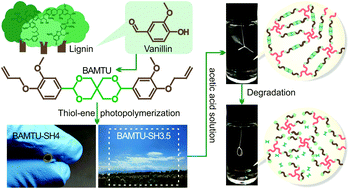Building biobased, degradable, flexible polymer networks from vanillin via thiol–ene “click” photopolymerization†
Abstract
Research on biobased degradable flexible polymers with high transparency and outstanding mechanical performance is of great importance for the rapid and sustainable development of flexible devices. Herein, renewable vanillin was chosen to synthesize a biobased allyl ether monomer (BAMTU) with high aromaticity and degradable acetal groups. BAMTU and thiol with different functionalities were then polymerized through thiol–ene “click” photopolymerization to form three kinds of thiol–ene networks (BAMTU-SH) with tunable properties. Their glass transition temperatures ranged from 20 to 49 °C, their tensile strength and elongation at break were 2.9–18.2 MPa and 103.5–305.6%, respectively. BAMTU-SH4 showed the best integrated mechanical performance, for which the toughness was the highest (14.5 MPa). These BAMTU-SH networks exhibited high transparency with a transmittance of 89.4–90.5% at 550 nm. Moreover, all of them could be degraded in mild acetic acid solution. The high-performance BAMTU-SH networks have potential applications in flexible device substrates while their degradability will contribute to environmental protection.



 Please wait while we load your content...
Please wait while we load your content...